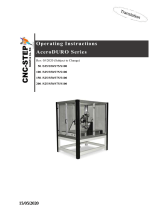
© ESAB AB 2010
-18-
bp08de2
5.2.2 Several power so u rces
1. Parallel connected operation – Connect the power sources according to section
3.6. Set the switch for local/remote operation in REMOTE mode, on both power
sources. If the units are used for cutting and both power sources are to supply
cutting current, activate the logic input HI CURRENT (pin T) in the CNC cable.
With this setting, the maximum current is 400 A at analogue input signal 10 VDC
from CNC. If the input HI CURRENT is deactivated, the auxiliary source's current
outout switches off, despite it being connected to the main power source. Only
the main power source produces current in marking mode. If marking and cutting
are carried alternately the input HI CURRENT can be left active, whereupon the
input for marking is controlled if both the power sources' current outputs or only
the main power source' s is to be active. The current range when marking is 10 to
36 A and when cutting 30 to 720 A.
5.3 Starting cutting and marking
1. Power the equipment by switching on the switch at the power socket ( the power
source does not have its own mains power switch). When the current source is
powered, the display window briefly shows EPP-360 and then Pr x.xx, (the
program version number) and then 0 A and 0 V.
2. Set the switch for local/remote operation in the desired m ode, depending on
whether the CNC unit can be remotely controlled.
a. During local operation (PANEL mode) you can display the set setpoint value
for cutting current by keeping the switch on the control panel in the position
for display of setpoint for cutting current. In PANEL mode, the power source
calculates pilot arc current, initial current and ramp up time from the set
cutting current setpoint value. You can display the set setpoint value for pilot
arc current by keeping the switch on the control panel in the position for
display of setpoint for pilot arc current. See section 5.1.2 Control panel.
b. In remote control mode, there are two possible operating modes.
1 The standard mode is similar to local operating mode, but the cutting
current signal comes from the CNC unit instead of from the control
panel's potentiometer. The scale for the current signal during remote
control operation is 1.0 VDC = 36 A. This mode can be used if the CNC
unit does not have functions for controlling initial current and ramp times.
Connections for remote control are based on the schedule for the CNC
interface.
2 If the CNC unit has functions for controlling the initial current and ramp
times, set the switch for local/remote control in REMOTE m ode, and
connects the pins R and V in the CNC contact. In this mode, the CNC
unit supplies analogue signals for controlling the values for initial current,
ramp up time and cutting current. The scale is the same as in the
standard mode. The pilot arc current is regulated by another analogue
signal, 0–10 VDC, if applicable, or using a binary signal according to the
schedule for the CNC unit's interface. The scale for the pilot arc current
signal is 10 VDC = 45 A.
3. Start plasma cutting. Variables such as gas pressure, flow, torch height etc. may
need to be set.
4. If cutting/marking, for any reason, cannot be initiated, the power source displays
a fault code that indicates the cause o f the fault, see Fault codes in the fault
tracing section.
GB





















